Chiggers, also known as “jiggers” or “red bugs,” are very tiny red bugs and that can cause extreme itching and annoyance to both you and your pets. Chigger bites don’t carry diseases but can be very uncomfortable so it is important to understand how to get rid of chiggers on your skin and in your yard. Shop our selection of professional grade products for chigger relief.
Products coming soon, we promise! Please check back here later!
Q: What are chiggers?
A: Chiggers are the larval stage of the red harvest mite. Only this stage of the mite affects humans or animals. The adult female mites lay eggs in the soil, and when these eggs hatch, the chiggers climb up to the top of the vegetation to catch a ride on a host human or animal.
Q: What do chiggers look like?
A: The larval stage has six legs, while adult and nymph mite stages have eight. Adult and nymphs are bright red, while the larvae are orange, yellow, or light red and 1/150 to 1/120 of an inch long. Adult mites are 1/20 inch long.
So what does a Chigger look like? Here are a few pictures of Chiggers:
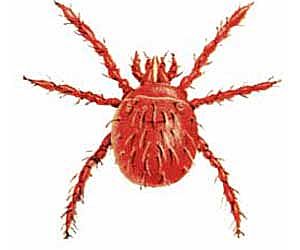
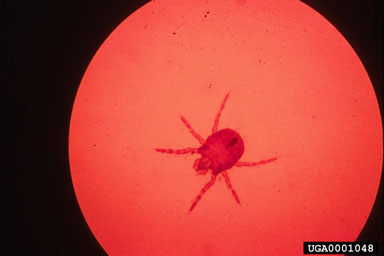
Image courtesy of Georgia State University
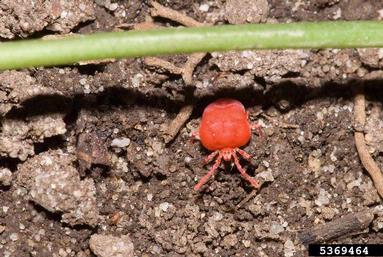
Image courtesy of Susan Ellis
Q: Where do chiggers live?
A: You can find chiggers in damp, low-lying areas, such as meadows, near lakes or rivers, and heavily wooded areas. Most often encountered in the spring and summer, chigger larvae hang on the tops of vegetation, usually in damp, shady areas.
Q: Do chiggers burrow under skin?
A: No, chiggers do not go under skin. Instead, they bury themselves in a hair follicle and pierce the skin, injecting the host with a secretion that breaks down skin cells, which the larvae ingest. After a few days (or after the chigger is full) it will drop off from the host.
Q: Where do chiggers bite and what do chigger bites look like?
A: Chiggers prefer to feed on areas of skin under tight clothing (like waistbands, socks, etc.) or where skin is thin or tender (ankles, armpits, back of knees, groin). A few hours after the chigger begins feeding, small, red itchy welts appear, sometimes with a white center. The itching welts can last for a week.
Here are a few pictures of Chigger bites to help you identify them.
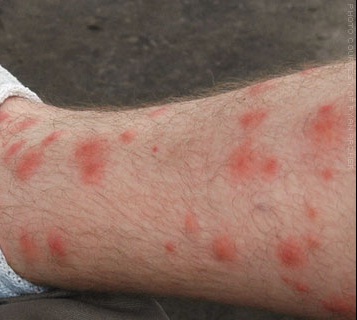
Image courtesy of horsehints.org
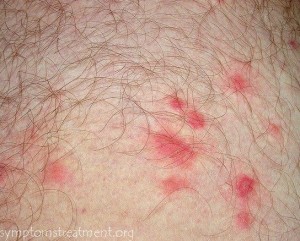
Image courtesy of symptomstreatment.org
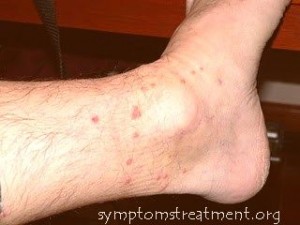
Image courtesy of symptomstreatment.org
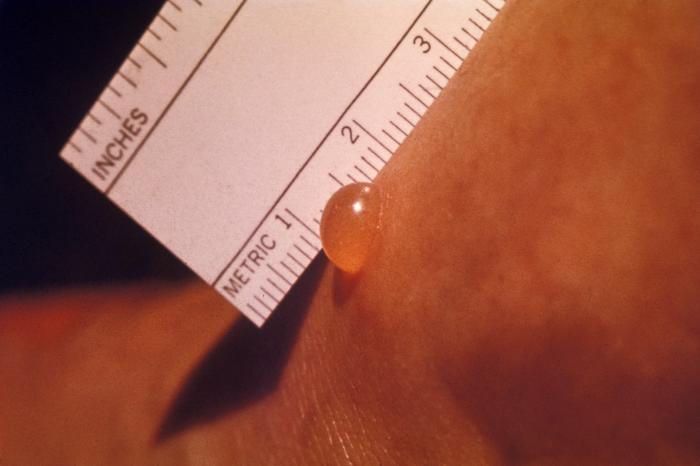
Image courtesy of cdc.gov
Q: How do I treat chigger bites?
A: After leaving a chigger–infested area wash clothes in very hot water to dislodge and kill the chiggers. Take a hot shower or bath and scrub skin with soap to dislodge chiggers. Make sure to wash all cracks and crevases really well. Skin will still itch, so applying calamine lotion, hydrocortisone ointment, benzocane, or other itch relief product. Some people find Vaseline, baby oil, and nail polish to be helpful. Treating as soon as possible is best.
Q: How do I get rid of chiggers in my yard?
A: Since chiggers love damp shady areas, removing these kind of habitats from your yard or property will keep chigger populations down. Mowing regularly, removing thick vegetation, thick briars, and eliminating shady areas can help. Chiggers like to congregate together, so there will be “hot spots” of chiggers. Spot-treating these known hot spots is the most efficient way to control chiggers. Spraying border fences between wooded areas, lawns, ornamental plantings, near the dog house, and hot spots with a bifenthrin product or a permethrin product.
Information via DoMyOwnPestControl.com experts, the University of Kentucky Entomology Extension, the University of Nebraska-Lancaster Extension, and Ohio State University Extension.
Can't find the product you are looking for? E-mail us and we'll get it for you!
We sell professional do it yourself pest control (diy), exterminator and
extermination insecticide, pesticide, chemical and bug killer treatment
products to spray, eliminate and exterminate pests.
Many of our products are not available in stores
such as Home Depot, Walmart or Lowes.